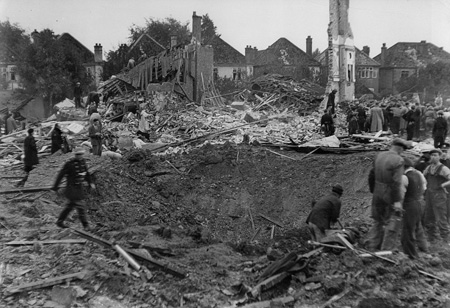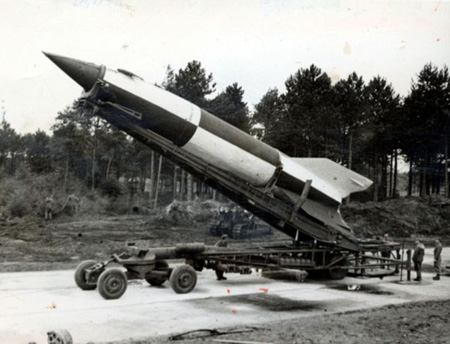




Back to the Around WWII calendar



 On June 6 1944, which has become known as D-Day, over 150,000 British, Canadian and United States forces landed on five beaches along the northern coast of France, an area known as Normandy. By the end of August, all the north of France had been freed from German control and by the following April the war in Europe was over.
On June 6 1944, which has become known as D-Day, over 150,000 British, Canadian and United States forces landed on five beaches along the northern coast of France, an area known as Normandy. By the end of August, all the north of France had been freed from German control and by the following April the war in Europe was over.
 However the invasion sparked a new blitz on London as Germany began sending over V1 rockets which could cause a lot of damage. The first V-1s were launched against London on June 13, 1944, a week after the D-Day landings. Over an 80 day period, more than 6,000 people were killed.
However the invasion sparked a new blitz on London as Germany began sending over V1 rockets which could cause a lot of damage. The first V-1s were launched against London on June 13, 1944, a week after the D-Day landings. Over an 80 day period, more than 6,000 people were killed.
The V1's were called “doodlebugs” and my mother used to tell me how you could here a humming sound as they came over and you waited because if the humming stopped, a few seconds later the rocket would hit the ground and explode. I guess you didn't actually wait but tried to take cover in a shelter nearby. But this was life in the big cities. Each morning you would get up and on your way to work or school you would see rescue workers clearing away debris from another street and searching for survivors. Unlike during the blitz when the weather could affect whether the German bombers could fly, the rockets could be launched at any time, day or night, bad weather or good. The slightly good news was that fighter planes and anti-aircraft guns could intercept and shoot down the rockets
 But, on September 8th 1944, a new rocket was launched. This was the V2. It travelled faster than the speed of sound, couldn't be heard and couldn't be shot down. By the way, the V stood for Vergeltungswaffen which was a German word meaning Vengeanace. Around 1,500 were launched between September and the following March and probably killed about 7,000 people. The first raid, on that September day, was on Chiswick in West London, the devastation shown in our picture on the right, and, amazingly, it only killed three people and injured 17. In November an attack hit a Woolworth's store in New Cross in South East London and that killed 168 people; England's worst death toll from a V2.
But, on September 8th 1944, a new rocket was launched. This was the V2. It travelled faster than the speed of sound, couldn't be heard and couldn't be shot down. By the way, the V stood for Vergeltungswaffen which was a German word meaning Vengeanace. Around 1,500 were launched between September and the following March and probably killed about 7,000 people. The first raid, on that September day, was on Chiswick in West London, the devastation shown in our picture on the right, and, amazingly, it only killed three people and injured 17. In November an attack hit a Woolworth's store in New Cross in South East London and that killed 168 people; England's worst death toll from a V2.
 The V2's were launched from mobile units, the 46ft (14m) tall rockets were fuelled by liquid ethanol and oxygen and weighed almost 14 tons. The missile was launched vertically and could travel at more than 3,500mph to hit targets more than 200 miles away. When it landed, it left a crater 60ft wide and 16ft deep and such was its speed, the noise of the rocket rushing through the air came after it landed.
The V2's were launched from mobile units, the 46ft (14m) tall rockets were fuelled by liquid ethanol and oxygen and weighed almost 14 tons. The missile was launched vertically and could travel at more than 3,500mph to hit targets more than 200 miles away. When it landed, it left a crater 60ft wide and 16ft deep and such was its speed, the noise of the rocket rushing through the air came after it landed.
As the V2 could climb 50 miles up into the air it was really the world's first space rocket. As soon as the war ended the United States and Russia raced to capture as many unused V2s as they could and the design was the basis for the first rockets sent into space. In October 1946, the first photograph was taken from space using a US-fired V2 rocket.
As the Allied troops advanced through France so the attacks from these rockets stopped as their bases were overrun by the soldiers.
Again, in the middle of the war, there was another piece of legislation which still affects you today. It was the 1944 Education Act sometimes called the Butler Act. The reason it was so called was that the man who introduced it was Mr R A Butler and he was sometimes known as RAB for obvious reasons.
In the years leading up to the war almost 80% of all children left school at 14. Pupils went to an elementary school and even if their parents were offered a free place at a private school, they couldn't afford it. As we know, for the first few years of the war, children were evacuated away from the big cities into the quieter, less dangerous, countryside.
 Butler's Act said that, after the war ended, every child would be able to go to a free school, paid for by the government and that this one act would replace all other previous laws on education. He replaced the Board of Education, which had run things, with the Ministry of Education, just as we have now.
Butler's Act said that, after the war ended, every child would be able to go to a free school, paid for by the government and that this one act would replace all other previous laws on education. He replaced the Board of Education, which had run things, with the Ministry of Education, just as we have now.
There were now to be 3 types of state secondary schooling. There would be grammar schools for those who had good academic skills, there would be technical schools for those who would benefit from learning a trade and, for every one else, there would be secondary modern schools. It was decided that Local Education Authorities would be asked to administer the new system and the schools. Interestingly Butler did not recommend the 11-plus test as a means of selecting children for the grammar schools; He wanted children to be judged according to their primary school records and the 11-plus only used as an extra means of deciding.
He managed to convince church leaders of his plan by promising that government would help pay for repairs to church school buildings. Religious education was also required in every state school although the schools could decide what form it should take. The Prime Minister, Winston Churchill, asked Butler to introduce a note of patriotism into the curriculum, mainly by emphasising history teaching. Butler ignored this and didn't specify any curriculum, letting schools and teachers decide. Just a little personal note here, I believe that teachers should be able to decide how and when things are taught as long as everyone arrives at the end of their education knowing all they need. I spent the first 2 years of my time at school in London, the next 3 in Leeds, before I came back to London. The subjects taught were quite different. When I got back my fellow pupils had spent 2 years learning French, I had not. I was way behind them. However, compared to them, I was a mathematical genius having studied far more in that subject. What do you think? Should we all learn the same thing in each year wherever we are or should teachers in individual schools be allowed to choose?
But back to Mr RAB, he also proposed in his Act that county colleges be set up for school leavers, at this time the leaving age was still 14, who wanted to continue in education until 18.
In 1947 the leaving age was raised to 15 and there were 5.5 million children in state schools. We will talk more about education in later timelines.
Despite Mr Butler's hopes the 11-plus, a simple intelligence test taken once at the end of primary schooling, did come to determine whether a child went to grammar school. That had a huge influence on people's chances in life as grammar schools were the only way to get to University, if you couldn't afford private education. Also very few technical schools opened and about 80% of all children ended up at a secondary modern school. The Act was a historic step forward but Acts of Parliament are only as good as the people who then enforce them. Since RA Butler in 1944 there have been 36 Ministers of Education, under various different titles. That works out at one every two years. By comparison there have been 22 Chancellors of the Exchequer, including good old RAB for 4 years, and 29 Home Secretaries, including good old RAB for 5 years this time.
Forward to 1945AD

